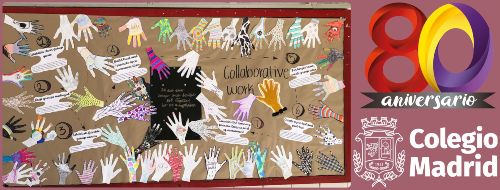Collaborative learning. Bulletin board in secondary

Collaborative learning is an approach that helps learners develop different skills in the classroom that will stay for the rest of their lives.
Collaborative learning involves students working in pairs or small groups to solve problems and find solutions. In pair work or teamwork learners teach each other and learn from each other; they can help their peers to understand concepts that were unclear or vice versa, they also develop social skills that are essential in an early age.
Some useful tips for a successful collaborative task are:
Establish clear goals: it will keep the team on task, learners have a clear idea of what to do and having clear objectives will help to save time.
Keep groups midsized: small groups may take longer to accomplish the objectives, and large groups may not all the members participate. Teams of 4 is the perfect size.
Establish flexible norms: interactivity and negotiation are important in teamwork.
Trust and open communication: it is important to build trust with effective and affective communication among team members and the teacher.
Create group roles: it is important that team members assign what roles each one is having (reporter, researcher, leader, fact-checker, etc.)
Create a pre-test and post-test: it will keep learners’ focus on the main aim and objectives of the task, it will also help the teacher check on the effectiveness of the team.
Consider the learning process itself as part of the assessment: collaborative learning is a process, and learners need to have a clear idea of what will be assessed during the process; that way they will provide motivation for learners, it will show learners that they evaluate meaningful group interactions, and not only the outcome.

Aprendizaje colaborativo
Periódico mural en secundaria
El aprendizaje colaborativo es un enfoque que ayuda a los alumnos a desarrollar diferentes habilidades en el aula, que permanecerán por el resto de sus vidas.
El aprendizaje colaborativo implica que los estudiantes trabajen en parejas o en pequeños grupos para resolver problemas y encontrar soluciones. En el trabajo en pareja o en equipo los estudiantes se enseñan unos a otros y aprenden unos de los otros, pueden ayudar a sus compañeros a comprender conceptos que no estaban claros o viceversa, también desarrollan habilidades sociales que son fundamentales en edades tempranas.
Algunos consejos útiles para un trabajo colaborativo exitoso son:
Establezca objetivos claros: mantendrá al equipo enfocado en la tarea, los alumnos tendrán una idea clara de qué hacer y tener objetivos claros ayudará a ahorrar tiempo.
Mantenga los grupos de tamaño mediano: los grupos pequeños pueden tardar más en lograr los objetivos y es posible que no todos los miembros participen en los grupos grandes. Equipos de 4 es el tamaño perfecto.
Establecer normas flexibles: la interactividad y la negociación son importantes en el trabajo en equipo.
Confianza y comunicación abierta: es importante generar confianza con una comunicación efectiva y afectiva entre los miembros del equipo y el docente.
Cree roles grupales: es importante que los miembros del equipo asignen qué rol tendrá cada uno (reportero, investigador, líder, verificador de informacion, etc.)
Cree una prueba previa y una prueba posterior: mantendrá a los alumnos enfocados en el objetivo principal y los objetivos de la tarea, también ayudará al maestro a verificar la efectividad del equipo.
Considere el proceso de aprendizaje como parte de la evaluación: el aprendizaje colaborativo es un proceso y los alumnos deben tener una idea clara de lo que se evaluará durante el mismo, de esa manera el docente proporcionará motivación para los alumnos, les mostrará que se evalúan interacciones grupales significativas y no sólo el resultado.
Alejandra Rosete
Profesora de inglés